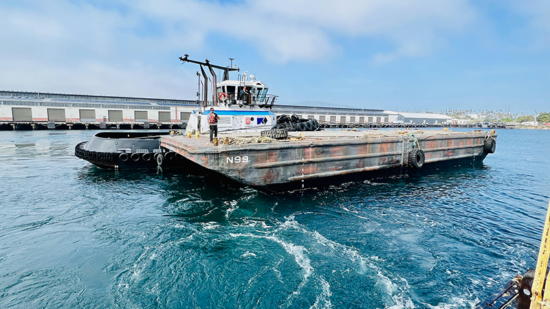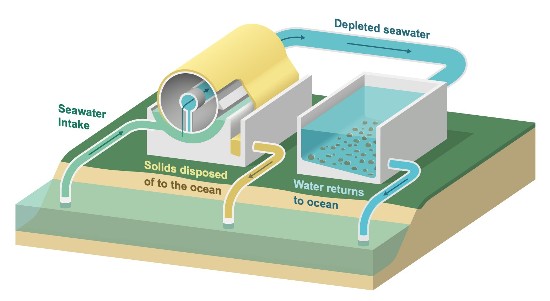SeaChange is a new business startup using a technology developed at the UCLA Samueli School of Engineering to enhance the world ocean’s ability to capture carbon dioxide (CO2) without the risk of further acidification. Essentially, the technology turns the gas into rock so that it no longer contributes to global warming.
Gaurav Sant, Director of the Institute of Carbon Management (ICM) at UCLA describes the invention as a “technology [that] can electrochemically enhance and restore the ocean’s capacity for carbon dioxide removal from the atmosphere at a globally relevant scale.”
The Ocean as a Natural Carbon Sink
Today, we add 37 billion tons of CO2 to the atmosphere annually. The biggest contributors are the fossil fuel industry, transportation, agriculture, buildings, and steel and cement manufacturing.
The world’s oceans absorb much of this CO2 which if there were no oceans would significantly raise temperatures around the planet to much higher levels than they are today. And CO2 can stay in the atmosphere for hundreds if not thousands of years without breaking down.
So seawater’s capacity to hold up to 150 times more CO2 than the atmosphere per unit volume has turned out to be our primary natural carbon sink. Forests and soil don’t come close. The problem with the oceans as natural carbon sinks is that they are working overtime because of the increasing volumes of CO2 we produce. With so much carbon getting into the ocean from CO2, our seawater is becoming more acidic (carbonic acid is the cause). And the more acidic the oceans become, the greater the threat to marine animals encased in shells and exoskeletons made from natural calcium composites. This is a growing threat to the entire food chain from plankton to fish and whales.
A SeaChange Alternative to Onland Carbon and Direct Air Capture
What SeaChange technology does is enhance ocean water’s ability to absorb CO2. It does this using a process that emulates what marine animals do when they build their exoskeletons and shells.
How does it work?
It passes seawater through an electrically-charged mesh that turns alkaline to react with the dissolved CO2 turning it into solid limestone and magnesite. These two types of rock make the carbon permanently inert.
The process then returns the water to the ocean but with no CO2 in it which makes the seawater a sponge for absorbing even more of the greenhouse gas (GHG). The solid rock can then be dumped into the ocean with no impact on marine life.
The process provides an additional benefit, green hydrogen, which can be used as a zero-emission energy source.
Why use SeaChange rather than the current carbon and direct-air capture technologies that are being built and operated in a few places around the world? The handful of carbon capture and sequestration (CCS) and direct-air capture (DAC) projects completed to date will not significantly reduce atmospheric CO2. At best, they can capture a few million tons of gas per year. But governments are incentivizing and the fossil fuel industry is clamouring for these types of facilities as global temperatures creep closer to the 1.5 Celsius (2.7 Fahrenheit) rise that the IPCC established as a safe benchmark for warming without dire consequences. How many thousands of these sites will we need to approve and build over the next thirty years to make a dent? Based on current behaviours by industry and government, I wouldn’t hold my breath waiting for them to be our carbon-emission-reducing answer to climate change.
Some academics and industry leaders, as well as policy wonks, have alternative proposals to geoengineer solutions that permanently alter the amount of sunlight reaching the planet so we can cool it down even in the presence of elevated CO2 levels. The impracticality of these geoengineering schemes and the unintended consequences of some of them failing which I have reported on this blog site, make these solutions foolhardy.
So how much CO2 would we need to remove using SeaChange to mitigate climate change? The estimate is between 10 and 20 billion tons annually from 1,800 plants situated in harbours and offshore locations around the world.
Why is SeaChange a better solution in combination with natural initiatives and conservation contributions from all of us? Turning CO2 into rock represents permanent storage. The carbon we capture using it can never return to the atmosphere for hundreds of millions of years. (The only way would be for the rock to be exposed to the air where it would weather over millions of years releasing the carbon.)
To get started SeaChange is launching two pilot demonstrations (see the image of one of these below), one in Los Angeles Harbour, and the other in Singapore. The pilot sites will demonstrate the effectiveness of the technology and be used to measure and optimize results. SeaChange is partnering with AltaSea a public-private institute and partnership, and the Port of Los Angeles for these first two field demonstrations.

















